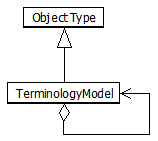TerminologyModel - Terminology model (internal data type)

A concept system as being defined in [1087] is a "set of concepts structured according to the relations among them". This corresponds very much to terminology models in TM.A concept system describes concepts used in the specific subject area. Explicitly defining a concept system might be a good starting point for defining a terminology model, but it is to general in order to reflect important principles of expressing knowledge in human language. Thus, the concept system has to be developed later on to a terminology model.
A terminology model also defines the object type to which the knowledge area to be described, belongs. This might be either an individual object (as a specific enterprise) or a general object (enterprises as such, represented by a specific view to enterprises). Thus, the terminology model for an accounting system for an individual company will describe the company as in individual object. Providing a generic solution, which might be used by any company, the application describes the general object company from the view of accounting processes.
In contrast to object instances, which are defined by an object type with well-defined features, model features are more flexible and may easily change depending on specific requirements. Practically, creating a new object collection means adding a new property to the model instance, but this is not considered as significant model modification, which probably will require database reorganization.
Each terminology model should be consistent in a way that it does not refer to types, which are not defined in the terminology model itself or one of its parents.
In [ERM] the entry points are tables, which are features in the context of a project or database. The project or database does exist, but is not defined as upper context. Similar, in the object model [ODMG], where technically different contexts are provided in terms of schema, module, namespace and type, the conceptual entry points are types and extents (properties).

